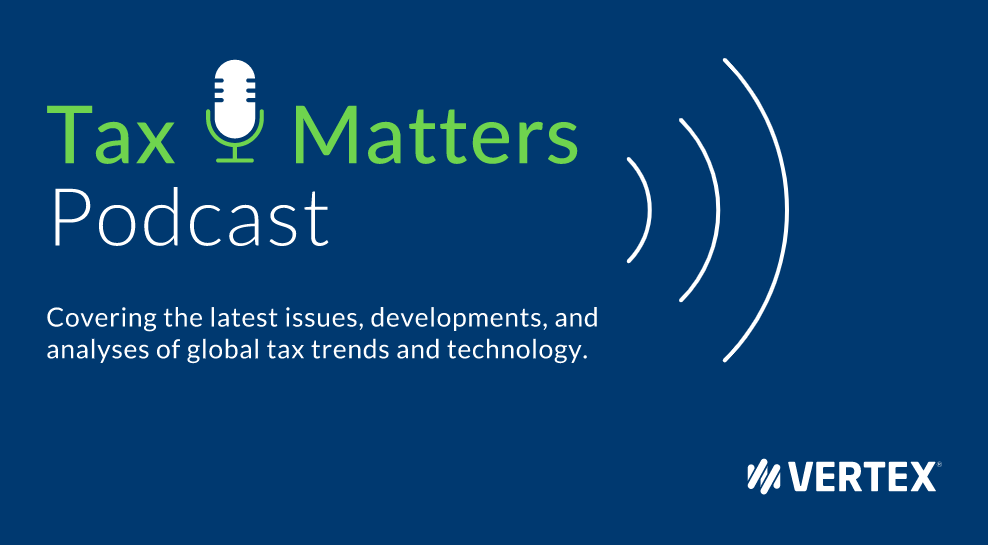Introduction
Welcome to Tax Matters, a Vertex podcast! I’m Rachel Litcofsky, Manager, Public Relations, at Vertex.
In this episode, Vertex Vice President of Tax Content and Chief Tax Officer Michael Bernard shares an early look at Vertex’s 2023 Mid-Year Sales Tax Rates and Rules report. Mike sits down with business writer Eric Krell to discuss U.S. sales tax rate changes that have occurred so far this year.
Mike examines a surge in district taxes, the growing use of fees and key factors driving rate changes – including sales tax exemptions. Mike concludes our podcast with a rundown of the sales tax trends he’ll be monitoring for the rest of the year.
Now, I’ll turn it over to Mike and Eric.
Eric Krell: Hi, Mike. It’s great to reconnect with you. Vertex’s mid-year, 2023 Sales Tax Rates and Rules report is just about finalized -- when you look at the data, what jumps out at you?
Michael Bernard: First of all, Eric, it’s good to be with you again. I think the story over the last six months has not really been on the state side. There’s been a lot of activity on income and property tax there, but for sales and use tax, it’s really been at the local [jurisdictions]. When we talk about the locals -- as you know, Eric - we’re talking about city, county and district levels. And the two things that we’re continuing to see is, one, their rates are running near all-time highs over the last 10-year period. And two, we continue to see increases of locals that come on board. That includes new jurisdictions that are actually imposing a sales tax. Second, those jurisdictions that have already imposed the sales tax, are actually increasing the rates. That’s what we’re seeing so far in the mid-year report.
Eric Krell: And the number of new district taxes continues to trend near or at an all-time high. Remind me what taxing districts are, and also what types of services they fund?
Michael Bernard: They fund a lot of essential services at the very local level. If you think about just driving around in your community, it has to do with public transportation. It can deal with electrical grids. It can deal with parks, police, fire, rescue and those kinds of things. It’s really the things in your neighborhood that are all around you for essential services. That’s what we’re talking about here.
Eric Krell: And again, new district taxes are up this year, but that’s continuing a multi-year trend. Separately, the number of new taxing cities that have appeared so far this year is extremely high compared to past years. What are some of the reasons behind these increases?
Michael Bernard: First and foremost, Eric, it’s about funding. If you think about these locals, they are consumers of products and services, just like you and I are. Now, think about what the rate of inflation has been over, say, the last couple of years … It’s been running in anywhere from 6% to 8% and sometimes higher in certain communities. This means that their costs are actually up from probably a baseline of 12% to somewhere around 18%. That’s a lot of additional revenue that they need in order to keep things going. I know we’ve talked about this in prior podcasts, Eric, but remember -- a lot of these places have cut their services, including their personnel, to kind of basic levels. And it’s tough for them if they want you to actually issue additional debt because the interest rates have gone up. The only way they can really fund and continue existing services, and maybe some capital improvements, is by raising the sales tax rate. That’s really what’s driving it.
Eric Krell: So, a lot of interrelated fiscal and economic pressures are playing out right now. What else is driving rate changes at the county, city and district levels in 2023?
Michael Bernard: A lot of things are coming into play…First of all, there’s been a lot of rainy-day funds that swelled due to federal aid. There’s also been income tax relief at the state level. There’s been property tax relief. Unfortunately, property taxes are under some heavy pressure, particularly as it relates to commercial real estate. While a lot of companies wanted people to come back to physical offices [after the pandemic], that’s leveled off and actually trended down a little bit. Commercial real estate is being re-valued, which means that the commercial property tax that locals take in has diminished… And additional residential real estate has kind of peaked due to higher interest rates. Now, the states and locals, but particularly the locals, need additional funding to kind of keep their services going. And a lot of things are in that services pot. Obviously, you want your roads to be well-maintained, you want your electrical grid, you want your parks to function. All these things need to function, including police forces, so that’s why rates are moving up.
Eric Krell: You point out a lot of things are in the pot and here’s something else that you’ve written about and talked about in that pot: there’s a surge in sales tax exemptions being enacted by state and local governments. Why are exemptions increasing? And tell me a little bit about the challenges they pose for indirect tax groups.
Michael Bernard: One thing you notice, is that many states have tried to provide relief through the pandemic and even coming out of the pandemic. As I mentioned earlier, this relief includes personal income tax rates at the state level coming down. Almost 25 states have done that. What state legislators have also tried to do is to have some type of exemptions, such as consumer taxes holidays. So, you’ve seen a lot of things like exemptions for personal care items, clothing, etc. And then more sales tax holidays, whether those are for three months or whether they’re permanent. That’s the kind of relief the legislators are trying to provide to their taxpayers.
Eric Krell: And it sounds to me like that adds to the complexity that sales tax groups have to contend with. Is that the case in terms of tracking these exemptions and keeping tabs on what’s permanent and what’s temporary?
Michael Bernard: Yes, most definitely. I mean, we saw some legislation by Florida, where they actually passed a kind of a different tax holiday, which related to disaster-relief items. If you’re in Florida, obviously they have inclement weather as it relates to hurricanes, so they put in a temporary law that allows individuals to go out and buy things that they would normally need in a hurricane disaster. Many of these exemptions are temporary. Retailers have to sell those things that are exempt on a personal basis, and then start taxing it later on [when the temporary exemption expires]. That … proves to be challenging to them.
Eric Krell: States are also rolling out more fees, including those related to retail delivery and the environment -- the green fees that we’re seeing. What do tax leaders need to know about these fees?
Michael Bernard: I think what they really need to know is that fees are just going to continue to proliferate. You mentioned a couple of them, including retail delivery fees. Colorado recently signed a fee on purchasers which exempts some qualified businesses. But for the most part, delivery fees are going to be the norm. There are green fees as they relate to bag fees, electronic goods, tires, anything that adversely affects the environment in that way. Right now, at Vertex, we’re supporting upwards of about a thousand of these different kinds of fees. The other thing is that we’re starting to see some things like resort fees. If you are going on vacation and you’re in an area that tends to be rather popular, sometimes they will add on an extra fee just for your hotel room or for dining in those areas. This is going to continue, and it’s actually quite popular with legislators in terms of imposing these fees to gain additional revenues.
Eric Krell: Mike, before we sign off today, tell us what sales tax related trends you plan to monitor the rest of the year?
Michael Bernard: I think there are a couple, Eric. One is that most legislative sessions are finished, so there’s going to be a lot of thinking over the next couple of months and into the fall around what legislators are going to do during the next session. We see NFTs being something that they want to tax. We also are concerned about ballot initiatives. Recently, both California and Ohio have moved to increase the number of signatures that ballot initiatives require in order to be put on a ballot. One of the things that’s happened over the last couple of years is that a lot of ballot initiatives have come up related, legislators have passed tax increases and then voters reject those. Essentially, what [some legislatures] are trying to do here is trying to limit the amount of initiatives that are actually on the ballot. We’re concerned about that because we always think that ballot initiatives are one of the great ways of achieving direct democracy vs. representations through the legislature. Those are some of the things that we’re looking at as we move forward through the summer and into the fall.
Eric Krell: Great, Mike. As always, it’s a pleasure talking to you. Thanks for taking the time today.
Michael Bernard: Thank you, Eric.
Rachel Litcofsky: Thank you for listening to Tax Matters, a Vertex podcast… Check back here for more episodes soon.
Note: This transcript has been edited for clarity.


